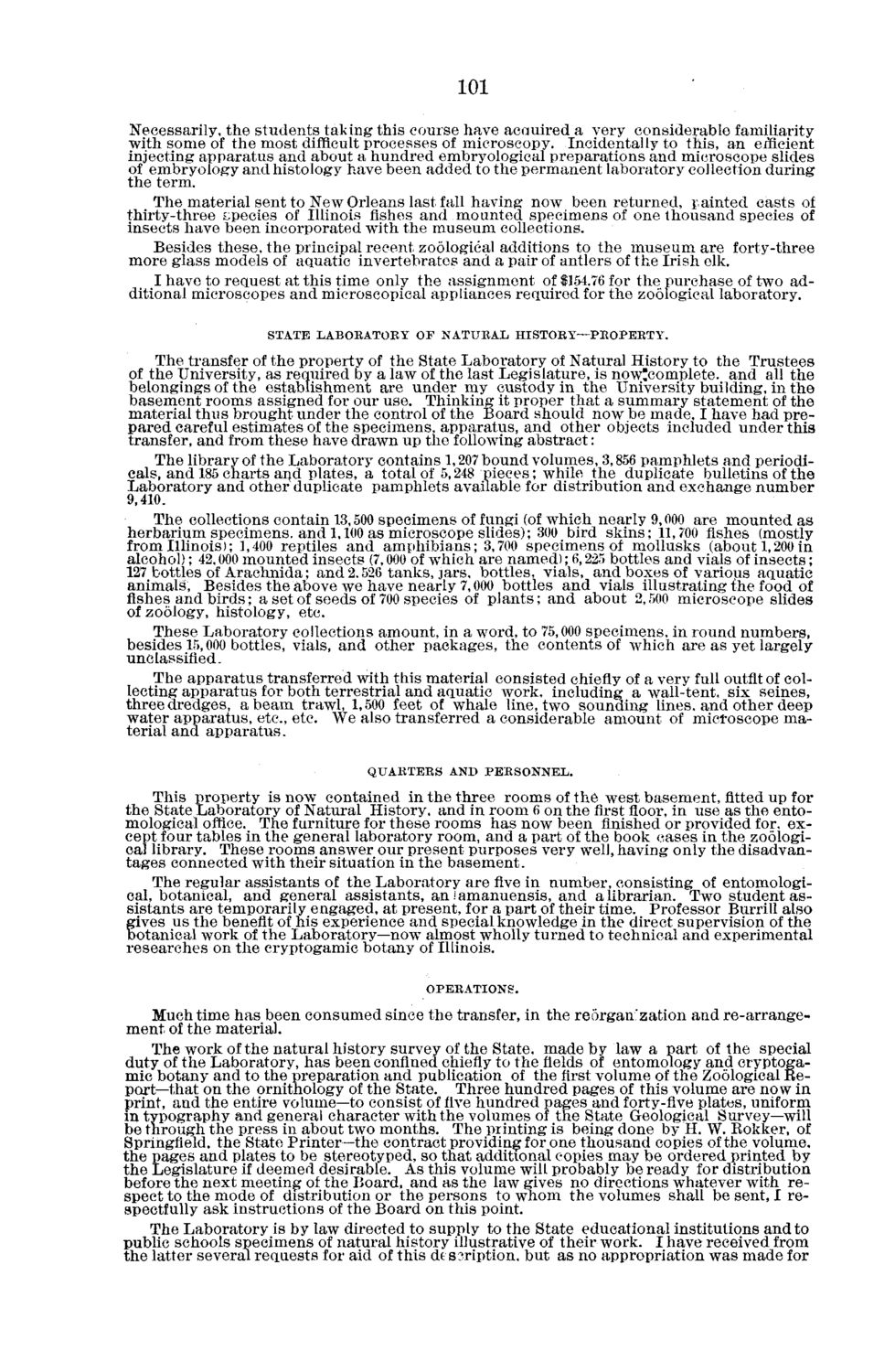| |
| |
Caption: Board of Trustees Minutes - 1886
This is a reduced-resolution page image for fast online browsing.

EXTRACTED TEXT FROM PAGE:
101 Necessarily, the students taking this course have acauired a very considerable familiarity with some of the most difficult processes of microscopy. Incidentally to this, an efficient injecting apparatus and about a hundred embryological preparations and microscope slides of embryology and histology have been added to the permanent laboratory collection during the term. The material sent to New Orleans last fall having now been returned, painted casts of thirty-three cpecies of Illinois fishes and mounted specimens of one thousand species of insects have been incorporated with the museum collections. Besides these, the principal recent zoological additions to the museum are forty-three more glass models of aquatic invertebrates and a pair of antlers of the Irish elk. I have to request at this time only the assignment of $154.76 for the purchase of two additional microscopes and microscopical appliances required for the zoological laboratory. STATE LABOEATOBY OF NATUEAL HISTOEY—PEOPEETY. The transfer of the property of the State Laboratory of Natural History to the Trustees of the University, as required by a law of the last Legislature, is now!complete. and all the belongings of the establishment are under my custody in the University building, in the basement rooms assigned for our use. Thinking it proper that a summary statement of the material thus brought under the control of the Board should now be made, I have had prepared careful estimates of the specimens, apparatus, and other objects included under this transfer, and from these have drawn up the following abstract: The library of the Laboratory contains 1,207 bound volumes, 3,856 pamphlets and periodicals, and 185 charts and plates, a total of 5,248 pieces; while the duplicate bulletins of the Laboratory and other duplicate pamphlets available for distribution and exchange number 9,410. The collections contain 13,500 specimens of fungi (of which nearly 9,000 are mounted as herbarium specimens, and 1,100 as microscope slides); 300 bird skins; 11,700 fishes (mostly from Illinois); 1,400 reptiles and amphibians; 3,700 specimens of mollusks (about 1,200 in alcohol); 42,000 mounted insects (7,000 of which are named); 6,225 bottles and vials of insects; 127 bottles of Arachnida; and 2.526 tanks, jars, bottles, vials, and boxes of various aquatic animals, Besides the above we have nearly 7,000 bottles and vials illustrating the food of fishes and birds; a set of seeds of 700 species of plants; and about 2,500 microscope slides of zoology, histology, etc. These Laboratory collections amount, in a word, to 75,000 specimens, in round numbers, besides 15,000 bottles, vials, and other packages, the contents of which are as yet largely unclassified. The apparatus transferred with this material consisted chiefly of a very full outfit of collecting apparatus for both terrestrial and aquatic work, including a wall-tent, six seines, three dredges, abeam trawl, 1,500 feet of whale line, two sounding lines, and other deep water apparatus, etc., etc. We also transferred a considerable amount of microscope material and apparatus. QUAETEES AND PEESONNEL. This property is now contained in the three rooms of the west basement, fitted up for the State Laboratory of Natural History, and in room 6 on the first floor, in use as the entomological office. The furniture for these rooms has now been finished or provided for, except four tables in the general laboratory room, and a part of the book cases in the zoological library. These rooms answer our present purposes very well, having only the disadvantages connected with their situation in the basement. The regular assistants of the Laboratory are five in number, consisting of entomological, botanical, and general assistants, an J amanuensis, and a librarian. Two student assistants are temporarily engaged, at present, for a part of their time. Professor Burrill also gives us the benefit of his experience and special knowledge in the direct supervision of the botanical work of the Laboratory—now almost wholly turned to technical and experimental researches on the cryptogamic botany of Illinois. OPEEATIONS. Much time has been consumed since the transfer, in the reorganization and re-arrangement of the material. The work of the natural history survey of the State, made by law a part of the special duty of the Laboratory, has been confined chiefly to the fields of entomology and cryptogamic botany and to the preparation and publication of the first volume of the Zoological Report—that on the ornithology of the State. Three hundred pages of this volume are now in print, and the entire volume—to consist of five hundred pages and forty-five plates, uniform in typography and general character with the volumes of the State Geological Survey—will be through the press in about two months. The printing is being done by H. W. Rokker, of Springfield, the State Printer—the contract providing for one thousand copies of the volume, the pages and plates to be stereotyped, so that additional copies may be ordered printed by the Legislature if deemed desirable. As this volume will probably be ready for distribution before the next meeting of the Board, and as the law gives no directions whatever with respect to the mode of distribution or the persons to whom the volumes shall be sent, I respectfully ask instructions of the Board on this point. The Laboratory is by law directed to supply to the State educational institutions and to public schools specimens of natural history illustrative of their work. I have received from the latter several requests for aid of this description, but as no appropriation was made for
| |